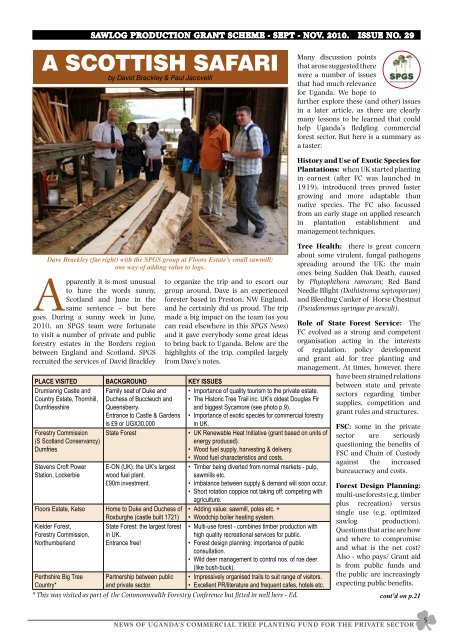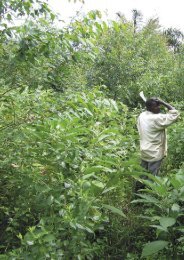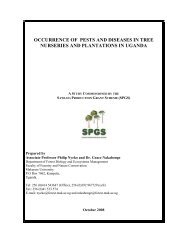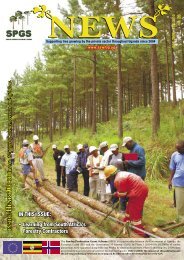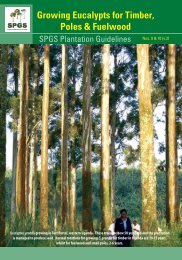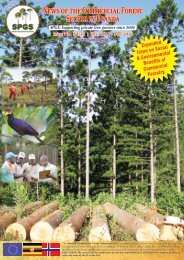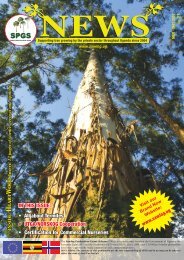You also want an ePaper? Increase the reach of your titles
YUMPU automatically turns print PDFs into web optimized ePapers that Google loves.
SAWLOG PRODUCTION GRANT SCHEME - SEPT - NOV. 2010. ISSUE NO. 29<br />
A SCOTTISH SAFARI<br />
by David Brackley & Paul Jacovelli<br />
Dave Brackley (far right) with the <strong>SPGS</strong> group at Floors Estate’s small sawmill:<br />
one way of adding value to logs.<br />
Apparently it is most unusual<br />
to have the words sunny,<br />
Scotland and June in the<br />
same sentence – but here<br />
goes. During a sunny week in June,<br />
2010, an <strong>SPGS</strong> team were fortunate<br />
to visit a number of private and public<br />
forestry estates in the Borders region<br />
between England and Scotland. <strong>SPGS</strong><br />
recruited the services of David Brackley<br />
PLACE VISITED BACKGROUND KEY ISSUES<br />
Drumlanrig Castle and<br />
Country Estate, Thornhill,<br />
Dumfriesshire<br />
Forestry Commission<br />
(S Scotland Conservancy)<br />
Dumfries<br />
Stevens Croft Power<br />
Station, Lockerbie<br />
Floors Estate, Kelso<br />
Kielder Forest,<br />
Forestry Commission,<br />
Northumberland<br />
Family seat of Duke and<br />
Duchess of Buccleuch and<br />
Queensberry.<br />
Entrance to Castle & Gardens<br />
is £9 or UGX30,000<br />
State Forest<br />
E-ON (UK): the UK’s largest<br />
wood fuel plant.<br />
£90m investment.<br />
Home to Duke and Duchess of<br />
Roxburghe (castle built 1721)<br />
State Forest: the largest forest<br />
in UK.<br />
Entrance free!<br />
to organize the trip and to escort our<br />
group around. Dave is an experienced<br />
forester based in Preston, NW England,<br />
and he certainly did us proud. The trip<br />
made a big impact on the team (as you<br />
can read elsewhere in this <strong>SPGS</strong> News)<br />
and it gave everybody some great ideas<br />
to bring back to Uganda. Below are the<br />
highlights of the trip, compiled largely<br />
from Dave’s notes.<br />
• Importance of quality tourism to the private estate.<br />
• The Historic Tree Trail inc. UK’s oldest Douglas Fir<br />
and biggest Sycamore (see photo p.9).<br />
• Importance of exotic species for commercial forestry<br />
in UK.<br />
• UK Renewable Heat Initiative (grant based on units of<br />
energy produced).<br />
• Wood fuel supply, harvesting & delivery.<br />
• Wood fuel characteristics and costs.<br />
• Timber being diverted from normal markets - pulp,<br />
sawmills etc.<br />
• Imbalance between supply & demand will soon occur.<br />
• Short rotation coppice not taking off: competing with<br />
agriculture.<br />
• Adding value: sawmill, poles etc. +<br />
• Woodchip boiler heating system.<br />
• Multi-use forest - combines timber production with<br />
high quality recreational services for public.<br />
• Forest design planning: importance of public<br />
consultation.<br />
• Wild deer management to control nos. of roe deer<br />
(like bush-buck).<br />
• Impressively organised trails to suit range of visitors.<br />
• Excellent PR/literature and frequent cafes, hotels etc.<br />
Perthshire Big Tree Partnership between public<br />
Country*<br />
and private sector.<br />
* This was visited as part of the Commonwealth Forestry Conference but fitted in well here - Ed.<br />
Many discussion points<br />
that arose suggested there<br />
were a number of issues<br />
that had much relevance<br />
for Uganda. We hope to<br />
further explore these (and other) issues<br />
in a later article, as there are clearly<br />
many lessons to be learned that could<br />
help Uganda’s fledgling commercial<br />
forest sector. But here is a summary as<br />
a taster:<br />
History and Use of Exotic Species for<br />
Plantations: when UK started planting<br />
in earnest (after FC was launched in<br />
1919), introduced trees proved faster<br />
growing and more adaptable than<br />
native species. The FC also focussed<br />
from an early stage on applied research<br />
in plantation establishment and<br />
management techniques.<br />
Tree Health: there is great concern<br />
about some virulent, fungal pathogens<br />
spreading around the UK: the main<br />
ones being Sudden Oak Death, caused<br />
by Phytophthora ramorum; Red Band<br />
Needle Blight (Dothistroma septosporum)<br />
and Bleeding Canker of Horse Chestnut<br />
(Pseudonomas syringae pv aesculi).<br />
Role of State Forest Service: The<br />
FC evolved as a strong and competent<br />
organisation acting in the interests<br />
of regulation, policy development<br />
and grant aid for tree planting and<br />
management. At times, however, there<br />
have been strained relations<br />
between state and private<br />
sectors regarding timber<br />
supplies, competition and<br />
grant rules and structures.<br />
FSC: some in the private<br />
sector are seriously<br />
questioning the benefits of<br />
FSC and Chain of Custody<br />
against the increased<br />
bureaucracy and costs.<br />
Forest Design Planning:<br />
multi-use forests (e.g. timber<br />
plus recreation) versus<br />
single use (e.g. optimized<br />
sawlog production).<br />
Questions that arise are how<br />
and where to compromise<br />
and what is the net cost?<br />
Also - who pays? Grant aid<br />
is from public funds and<br />
the public are increasingly<br />
expecting public benefits.<br />
cont’d on p.21<br />
NEWS OF UGANDA’S COMMERCIAL TREE PLANTING FUND FOR THE PRIVATE SECTOR<br />
5


